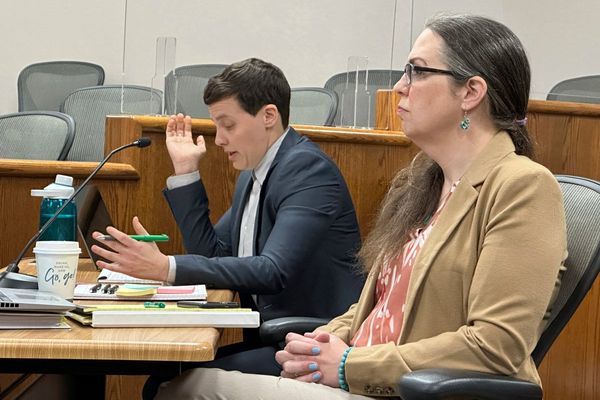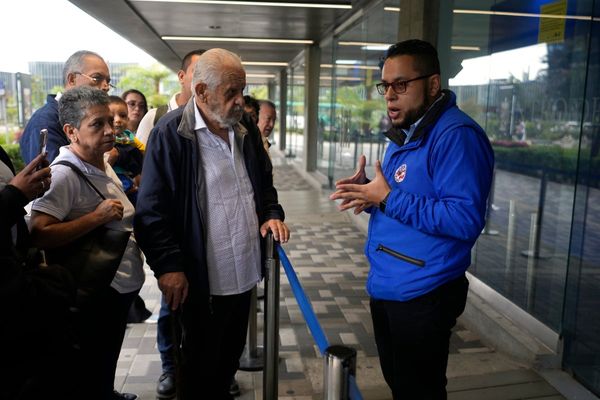Native American groups say food is both identity and power, something they want Washington to understand as they seek more control of their own diets, more traditional foods in aid programs and bigger roles for Indigenous American farmers.
The groups are eyeing not only the Food Distribution Program on Indian Reservations, or FDPIR, but also the Women Infants and Children nutrition programs, the Commodity Supplemental Food Program and even the Supplemental Nutrition Assistance Program. Greater tribal control would encompass funding and include the right to buy produce from tribal farmers.
“Feeding your own people, there’s nothing better than that,” said Mary Greene-Trottier, who is food distribution director for the Spirit Lake Tribe in North Dakota and president of the National Association of Food Distribution Programs on Indian Reservations.
Liz Malerba, policy director for United South and Eastern Tribes, said the Agriculture Department’s oversight of FDPIR means the federal government sets the diet of thousands of Native Americans. She acknowledged that the USDA has included some cultural foods in the aid in recent years but said the tribes should have full authority over the program.
“For generations, FDPIR and the commodities program that preceded it involved the federal government making decisions about what tribal citizens were eating,” Malerba said. She is a citizen of the Mohegan tribe.
The groups’ best shot at change could come with the farm bill that’s expected to take shape in 2023. They are hoping to build on gains in the 2018 farm bill that authorized pilot projects for tribal organizations to buy food from local farmers for the FDPIR.
The groups’ goal is to enlarge Native American farmers’ markets and increase demand. Traditional foods such as bison, salmon and walleye could return to tribal diets through federal food aid. Nations such as the Cherokee, Chickasaw, Choctaw, Muscogee and Seminole, all forcibly resettled long ago, would be able to rebuild traditions.
“Every tribe is different. One thing that is central to every tribe is that food is part of their cultural creation story. Food being part of their spiritual creation story is central to every tribe,” said Toni Stanger-McLaughlin, CEO of the Native American Agriculture Fund, a philanthropic trust. Stanger-McLaughlin is a citizen of the Colville Confederated Tribes.
House Rules Chairman Jim McGovern, D-Mass., and House Natural Resources Chair Raúl M. Grijalva, D-Ariz., say they want to take a broad look at Native agriculture and anti-hunger efforts. McGovern has held several hearings on food needs, problems and solutions and plans one on indigenous nutrition and food systems. He also wants the Biden administration to convene a White House conference on hunger.
About 25 percent of Native Americans received some form of federal food assistance, with participation in some communities much higher, according to most estimates.
The FDPIR is one of four programs that provide food aid to Native Americans, and the only one specifically designed for tribal communities. Established by a 1977 law, the program was a nod to the remoteness of tribal communities and scarcity of food retailers serving them.
Tribal lands are home today to about 30 percent of 7.1 million people who identify as Native Americans and Alaska Natives. The FDPIR aids about 276 of the 574 federally recognized tribes. In fiscal 2020, the program served 75,000 adults and children a month on reservations or in designated areas near reservations. Appropriators provided $162.2 million for program operations in fiscal 2021.
Limited say on diet
But the 105 tribal organizations that help operate FDPIR have limited say about the foods provided or about spending the money to boost Native American agriculture.
Rebecca Naragon, director of economic development for United South and Eastern Tribes, said expanding market opportunities for Native American producers will ripple through tribal economies and benefit other businesses.
“It could lead to building generational wealth for tribal citizens,” said Naragon, a citizen of the Poarch Band of Creek Indians.
Members of the Native American groups can also use broad food aid programs, including WIC, the Commodity Supplemental Food Program, SNAP and school lunch programs. But those programs are run by state agencies on reservations.
In at least one case, the state control adds to the logistical challenges. The Navajo Nation sprawls into three states, putting tribal leaders in a position where they have to work with agencies in Arizona, New Mexico and Utah.
Greene-Trottier says full tribal control of distribution won’t change the 120-mile distances she has to cover or the overnight stays that other providers need. But she said it would leave them freer to experiment with other delivery methods.
Agriculture Secretary Tom Vilsack told McGovern at a hearing in January that eight demonstration projects with eight tribes could make more indigenous foods available. And he agreed that local purchases can boost tribal economies.
“It’s also about creating economic opportunities and to the extent you create a local and regional food system, one that is designed to produce those culturally appropriate foods. You are also creating jobs,” Vilsack said, adding that USDA will continue to work with tribes on the issue.
The 2018 farm bill authorized $5 million for the projects, but Congress appropriated $3 million in fiscal 2020.
Greene-Trottier said the USDA demonstration projects offer a break in “having the federal government choose what food products are best for us.” Greene-Trottier and Stanger-McLaughlin both said more tribal authority could have eased disruptions in food supply during the pandemic.
Native American food program operators and advocates say the paperwork required for farmers to qualify to provide food for the national food distribution program is burdensome. Give food distribution directors on reservations authority to buy locally produced foods to cut the paperwork, they say. Advocates say the requirement that the distribution programs order their food packages from USDA limits opportunities for tribal organizations to help build regional food systems, which are considered avenues to markets for small and medium-sized operations.
A USDA census update in 2017 found almost 79,200 livestock and crop operations run by Native Americans or Alaska Natives, accounting for 2.3 percent of all farmers. But 80 percent were in 12 states, mostly in the West. The category accounted for 59 percent of the farmers in Arizona.
The group sold $3.5 billion in agriculture goods in 2017, just under 1 percent of all U.S farm goods. And 63 percent of the Native farmers reported sales and government payments of less than $5,000, more than the 44 percent of all farmers below that threshold.
Eyeing the 2023 farm bill
Greene-Trottier, who testified before a House Agriculture subcommittee in December, said she hoped lawmakers “have empathy towards underserved populations, remote areas, and understand the complexity of making sure people are fed” as they work on a 2023 farm bill.
In a December report, three organizations said tribal control of operations is needed to target policies to address food needs and develop Native communities’ economies.
Stanger-McLaughlin, whose group was one of the three behind the study, said the self-governance authority for tribes exists with other agencies, but until the 2018 farm bill it did not exist at USDA.
The Indigenous Food and Agriculture Initiative at the University of Arkansas School of Law and the Food Research & Action Center, an anti-hunger advocacy and research organization, were also involved in the report.
“In accordance with Tribal sovereignty, Tribal governments should have the right to choose to administer all federal food programs like SNAP and the child nutrition programs, including school meals, summer meals, and CACFP,” the report said.
Stanger-McLaughlin said the authority would allow the tribal organizations to tailor food packages.
“By allowing tribal communities to purchase locally and even regionally, certain tribes can work together, but it will allow them to have more nutritionally dense food that is from the community that is more digestible because it is food they have had within their food space traditionally,” she said.
Malerba said federal practice is inconsistent with a 1975 law that says the federal government should promote tribal sovereignty, but getting lawmakers to understand federal obligations to tribes is itself a challenge.
“When we talk about tribal self-governance, a lot of times eyes glaze over and we have to start from square one,” she said.
The post Tribal groups want to boost traditional diets in federal food aid appeared first on Roll Call.







